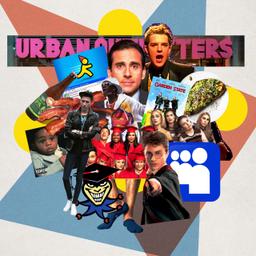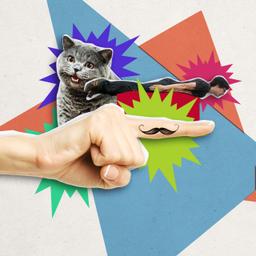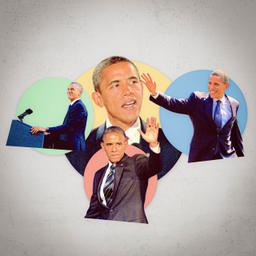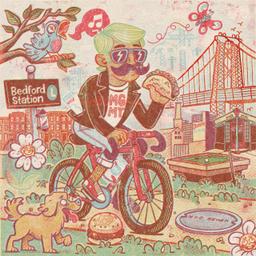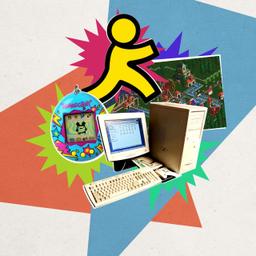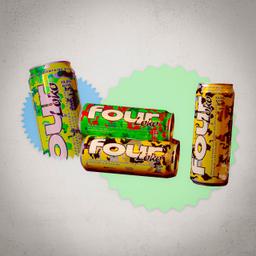Anyone who’s worked an office job in America this century has been there. It’s noon, you’re at your desk, and you’re hungry. A pastrami sandwich sounds good. So does a burrito. Sadly, those fantasies fade fast.
You realize that if you go that route, your afternoon will be ruined. You’ll be overstuffed. You’ll just want to take a nap. Your laptop—which, obviously, is what you’ll be eating this meal over—will end up covered in grease and crumbs. You sigh deeply and settle for a slightly lighter option. You head to a bright, minimalist, fast-casual place down the street; go to the counter; pick a green, a grain, a protein, veggies, crunchy toppings, and a dressing heavy enough to undermine the meal’s mission. A friendly employee will toss that stuff into a recyclable container, and you’ll pay about 15 bucks, rush back to your cubicle, and shove forkfuls of arugula into your mouth as you reply to Slack messages.
“It’s like conveyor-belt lunch,” says Mike Mitchell, cohost of Doughboys, a comedy podcast about chain restaurants. When you finally swallow that last shred of carrot, you’ll be full—just not of joy. “At least it’s not Subway,” you’ll claim to yourself.
The millennial embrace of food culture has helped lead to dozens of trends: bacon, gastropubs, cronuts, cupcakes, smashburgers, avocado toast, Nashville hot chicken, meal kits, Guy Fieri. But none embodies the generation’s consumer experience quite like the bowl. It’s just one example of a slick, streamlined product pushed on us as a “bold” way to improve our daily lives. Like Away suitcases or Warby Parker glasses, the bowl is exquisitely engineered, focus grouped, aesthetically pleasing, and sold as something that stands out from the rest. But now it’s ubiquitous. And it always ends up feeling like everything else.
“It’s the ultimate compromise meal,” says Bret Thorn, senior food editor at the trade publication Nation’s Restaurant News. “You want something that’s going to be not that expensive and it’s going to taste pretty good and be reasonably good for you. But trying to cobble all of that together in a bowl tastes like mediocrity most of the time.”
“It’s a nutrition pile,” adds Nick Wiger, cohost of Doughboys. “It’s pure sustenance. It’s not something that you’re eating for pleasure.”
On the surface, the bowl is a perfect lunch. It’s usually fresh, relatively healthy, and infinitely customizable. But underneath that layer of tortilla strips is something that, well, seems like less than the sum of its parts. If the evolution of media consumption over the past decade has taught us anything, it’s that endless choice and efficiency aren’t a formula for satisfaction.
The bowl’s trick is that it makes you believe you’re eating something more cravable than it really is. “With a bowl, you’re like, ‘I’m getting a bowl, not a salad,’” Mitchell says. “And a lot of times, you’re getting a salad, basically. But with a bowl, maybe it has some rice in there, or maybe it has some other stuff, and ‘I’m having a little bit more fun.’”
After a while, though, all those bowls start to blend together. They’re consistently, unmemorably safe. Which might be why the dining concept is becoming increasingly popular. According to the research firm Technomic, the number of bowl and/or salad outlets in the United States has doubled since 2019.
Most of the 6,000 or so bowl restaurants are part of local chains with five to 10 locations. As of early April, the top three chains by number of locations nationally were Mediterranean-infused Cava (367), acai spot Playa Bowls (290), and the high-end salad joint Sweetgreen (246). They may have a tiny collective footprint compared to fast food behemoths like McDonald’s or Starbucks, but by now they’ve popped up in cities and suburbs across the country. A decade ago, when I saw that a poke place had opened in the food court of my childhood mall on Boston’s North Shore, a region that Dunkin’ Donuts once had to convince that a turkey sausage breakfast sandwich wasn’t “weeyid,” I knew bowls had staying power.
Given our recent history, the trend is unlikelier than it seems. Early in the pandemic, the work lunch was marked for extinction. Millions of people went remote. “It’s impossible to talk about anything in this decade without acknowledging COVID,” Wiger says. “We weren’t sure we were going to return to a working-in-office culture.” But now it’s back. And the bowl is here to stay.
Over the past 20 years, Washington Post food reporter Tim Carman has had a front-row seat to the bowl explosion. The DMV is where Sweetgreen, Cava, and Chipotle’s short-lived Southeast Asian chain, ShopHouse, all started. Which makes sense: The region has always been full of office workers in search of a quick lunch. “We’ve just got the right demographics that these companies look for,” says Carman, a James Beard Award winner. “If a trend succeeds in D.C., it has a likelihood for larger success.” He understood the allure of the bowl, even if it wasn’t as mouthwatering as a Popeye’s spicy chicken sandwich: “It appealed to workers who sat at their desk and wanted to eat something that was easy and right there by their elbow.”
Here’s where we should state the obvious: The bowl isn’t an innovation. Humans have been eating food out of bowls for thousands of years. Anyone who’s had bibimbap, or donburi, or cacio e pepe, or dan dan noodles—all things, by the way, that you can easily find in the U.S. nowadays—will tell you how satisfying a meal with such an efficient delivery system can be. “If you’re talking about a transcendent experience, one that still has a magical powerful effect on me every time, it’s spicy noodles in broth somewhere in Southeast Asia,” Anthony Bourdain told Uproxx in 2016. “Or a bowl of pasta, working-class pasta, and some cheap wine in Italy. That’s what thrills me and fills me with joy and makes me believe that food is magic again.”
There are reasons, Carman says, why we enjoy eating out of bowls. “Often people pick it up, especially in Chinese culture, and hold it closer to your senses. There is this tactile, sensory experience with your food, which I think is really enjoyable.”
And let’s face it: The bowl is more aesthetically pleasing than a Big Mac. Which brings up another millennial pastime: posting on social media. “You want your lunch to look great so that you can make people jealous, I guess, as you post it on Instagram or TikTok,” Thorn says. “Which is kind of ironic, because once you get a bowl and you mix it all together, it just looks like—and I don’t say this in a bad way—a compost heap.”
The dishes Bourdain mentioned are traditional, simple, and soulful. And then there’s the most American version of the bowl, which is none of those things. In 2006, KFC introduced the Famous Bowl, a plastic trough of popcorn chicken, mashed potatoes, gravy, corn, and cheese. Comedian Patton Oswalt was so repulsed by the goopy mound that he responded with maybe his most Famous bit. “America has spoken,” he said onstage in 2007. “Pile my food in a fucking bowl like I’m a dog. I don’t give a shit anymore. If there’s any way you could put my dinner in a blender and liquefy it, and then put it into a caulking gun and inject it into my femoral artery, that would be even better. But I know you don’t have a lunch gun, so until you invent that, just make me a fuckin’ failure pile in a sadness bowl.”
One restaurant did rise to ubiquity with a bowl that felt slightly less like a failure pile. That was Chipotle. As far back as the mid-’90s, before low-carb diets became a full-on craze, customers were asking for their burritos without tortillas. “We would line the red baskets with foil and then use that as the bowl,” Gretchen Selfridge, Chipotle’s former chief operations officer and manager of the chain’s second location, told Bloomberg in 2015. “We would say, ‘If you're going to take it home, could you do us a favor and just bring it back after you get a collection of them?’”
In the 2000s, Chipotle officially added the burrito bowl to the menu. In 2015, The Huffington Post reported that the chain was selling more bowls than burritos. By then, bowl chains had sprouted up all over the U.S. There was Just Salad, Salad and Go, and Salata. And also Chopt, whose employees use a mezzaluna knife to slice and dice kale Caesars down to the consistency of lawn clippings. (Or at least they used to. In a move that is depressingly representative of the times millennials live in, getting your salad “chopped” at Chopt no longer comes standard.)
These restaurants, clearly eager to separate themselves from mass-produced fast food, began selling themselves as morally superior places to eat. They touted their “unprocessed,” “organic,” “eco-friendly,” and “sustainable” ingredients. In the Obama era, save the planet, one bowl at a time was a cynically effective marketing message—particularly for young adults concerned about the environment.
Big shock, though: Even the crunchiest corporations have trouble living up to their idealism. For a while, signs inside Sweetgreens claimed that “Nothing from inside Sweetgreen goes to the landfill.” That, the Los Angeles Times reported, turned out to be false. Mass composting, you see, wasn’t available in every city. The chain also struggled to come up with a truly recyclable bowl, which cofounder Nicolas Jammet acknowledged was a major problem. “Consumers care more and more about it today than ever,” he told the Times. “Because it’s something everyone touches, right?”
Sweetgreen’s anti-greenwashing stance is admirable, though it wasn’t just taken out of the goodness of the company’s heart. Founded by three Georgetown business school graduates, backed by hundreds of millions of venture capital dollars, and now publicly traded, the former startup almost certainly wouldn’t be making, in its own words, decisions “rooted in intention, integrity and meticulous care” if those decisions didn’t also boost its bottom line. Every single thing about Sweetgreen, down to the size of the chunks of apple in your salad, is meticulously optimized. It is, Mitchell correctly points out, “a tech company.”
Even if bowls can feel closer to Soylent Green than Remy’s ratatouille—“They often taste like they were designed by committee,” Thorn says—it’s also hard to deny that Sweetgreen’s Silicon Valley–like R&D has led to some of the best-tasting quick lunches out there.
That is, if you stick to the preset menu. A create-your-own bowl might look delicious on paper, but it’s fool’s gold. As anyone who’s ever been stuck scrolling through Netflix on a Saturday night will tell you, having too many choices can be exhaustingly paralyzing. Oftentimes, being a millennial means giving in to the algorithm. “You give people customization options, but the people don’t know what the hell to do,” Carman says. “They don’t have any culinary knowledge to know what pairs well or what would make for a delicious bowl.”
And so when building their own bowl, people tend to pick what they think they like instead of what’s actually good. Which can lead to disappointment. “What you have,” Thorn says, “is a bowl that just tastes like chaos.”
The bowl has turned into a yuppie symbol. Sweetgreen, especially, is a favorite among the upwardly mobile. “It is so connected, specifically, not to just any worker, but specifically to white-collar jobs,” Wiger says.
During the digital media, um, salad days of the 2010s, a journalist friend of mine ate a bowl lunch on his company’s dime five days a week. Eater once held a best bowl food tournament. (Cava came out on top.) Doughboys had one, too. (Sweetgreen and Chipotle were cochamps.) Prince Harry and Meghan Markle served bowls at their wedding reception, prompting the BBC to publish a short article about the trend. “The idea behind a bowl food menu is so guests can stay standing up and mingle while they eat,” the article explained. “It has been described by caterers as an option which allows guests to ‘keep on talking.’”
The bowl is now a punch line again, but in a different way than it was in the aughts, when Oswalt coined the phrase “failure pile.” It’s synonymous not with American excess but with the country’s descent into technocracy. Last year, Guardian columnist Emma Beddington visited Boston and observed “twentysomething STEM graduates” eating bowls. “It feels as if this constituency of engineers, data scientists, and microbiologists looked at the inefficient, emotionally charged business of ‘eating’ and thought, hmm, this could be optimized,” Beddington wrote. “Let’s simplify and streamline it into an efficient nutrient delivery system, ensuring macros are checked off, and requisite kilocalories delivered to fuel eight more hours of programming or equations or whatever.”
In a video from July 2020, comedian Conner O’Malley—perhaps our resident millennial ombudsman, in ways millennials might hate to admit—mockingly serenaded then–New York City Mayor Bill de Blasio for his response to COVID-19 and that summer’s anti-racism protests. “I want to thank you, Bill, for Operation Midtown Bowl Rescue,” he declares while violently coughing, “where you sent in the National Guard to protect midtown’s bowl restaurants from looters who are trying to break in there and steal edamame and carrot shavings.”
Alas, midtown’s bowl restaurants are still thriving. In fact, they’re also booming outside coastal cities. Cava now has locations in 26 states and D.C. and reportedly has plans to open 60-plus stores this year. There are now Sweetgreens in 22 states and D.C. The salad place even recently gave in to American chain tradition and introduced french fries. “Do they all just turn into McDonald’s eventually?” Mitchell says.
Mitchell and Wiger, who have tried hundreds of fast food restaurants for their podcast, expect the bowl craze to rub off on chains like Burger King. “Could we see a Whopper Bowl?” Wiger asks. When Mitchell hears that, a chill runs down his spine. “God,” he says. “The Whopper Bowl.”
The big boys are already adding more bowls to their menus. Last year, Taco Bell debuted the Cantina Chicken Bowl. And in 2022, Papa John’s introduced the Papa Bowl. “It’s a carnival barker promising a werewolf boy, a woman with four legs, fleas that can rotate a Ferris wheel, a pizza bowl without crust,” Carman wrote in his review of the failure pizza. “When you finally peek behind the curtain, all you discover is remorse.” (Local chains have gotten into the act, too. If you’re ever in Upstate New York, you can order a pizza bowl from Salvatore’s. As the menu claims, it’s “keto-friendly!”)
The bowl isn’t going anywhere. Thorn, for one, is fairly optimistic about its future. He’s hoping that bowl chains lean into preset menu options. “I think that is a direction people will go to during stressful times, which these certainly are,” he says. “I don’t want to make a choice, just give me lunch.”
At their best, that’s what bowls provide millennials trying to make sense of a miserable world: temporary peace of mind. But as is so often the case with this generation, that comfort comes at the expense of excitement. “Soulless is the right word to use,” Wiger says. “That’s what it feels like. It is purely functional. It’s just restoring my health bar.”
Sometimes, the stomachache, the sleepiness, and the calories of a heavy lunch are worth it. But not today. It’s 12:09 p.m., and you have work to do. So you’ll grab a bowl. You’ll be full afterward, but you won’t remember much about the meal. The next day you’ll order the same thing again.
